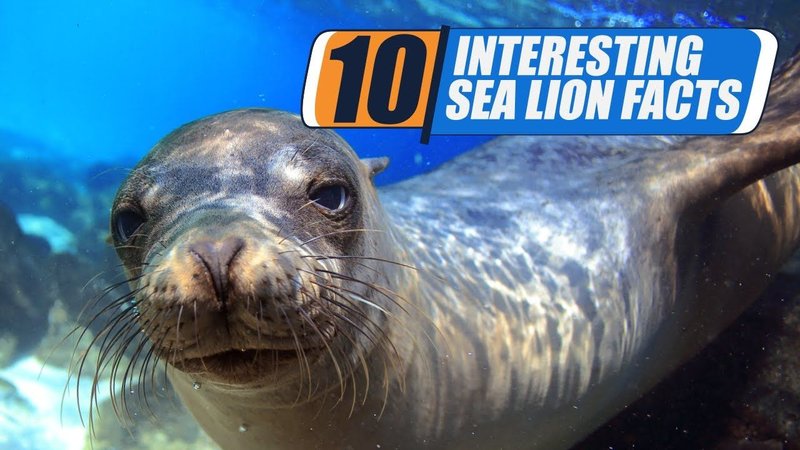
Let’s dive into the world of sea lions. You might be surprised by how much they can teach us about life in the ocean. From their playful nature to their impressive physical abilities, these animals are full of surprises. So, grab a comfy seat, and let’s explore ten fascinating facts about sea lions that will make you appreciate them even more!
1. They Are Not True Seals
You might picture sea lions and seals as the same thing, but they’re actually quite different. Sea lions belong to a group called **eared seals**, which also includes fur seals. This group is distinct because of their external ear flaps, unlike true seals that have holes where ears would be. Think of it like a family reunion—some relatives look similar, but they have their own unique features.
But here’s the kicker: sea lions are more agile on land compared to true seals. They can rotate their hind flippers forward, allowing them to walk on all fours, while true seals scoot around on their bellies. Imagine seeing a dog sprinting in a park—quick, nimble, and ready to play. That’s what it’s like to watch a sea lion strut around!
2. They Are Social Creatures
Sea lions are super social animals. They love to hang out in groups called **colonies**. In these colonies, you’ll find hundreds or even thousands of sea lions lounging on rocks or sandy beaches, basking in the sun. Honestly, it’s like their version of a beach party!
What’s interesting is how these social dynamics work. Sea lions communicate using a variety of sounds, including barks and growls. When you hear them, it’s like they’re having their own lively conversation! These vocalizations help them maintain order and establish territories within the colony. You might wonder how they always seem to know who’s who—it’s all about practice and familiarity!
3. They Have Amazing Memory Skills
Sea lions are known for their impressive memory. Research shows that they can remember specific sounds, shapes, and even tasks for years! Imagine being able to remember every detail of that beach trip you took as a kid. That’s how sea lions process their experiences.
This memory ability makes them great learners. They can be trained to perform tricks, which is why you might see them in aquariums or marine shows. Trainers often use positive reinforcement—like treats or praise—to teach them new behaviors. It’s all about making learning fun, just like how we enjoy games that challenge our minds!
4. They Are Incredible Swimmers
If you ever get the chance to watch a sea lion swim, do it! They’re remarkably agile in the water, reaching speeds of up to **25 miles per hour**. That’s faster than most speeding cars in a neighborhood! Their streamlined bodies and powerful flippers allow them to swim effortlessly, almost like a torpedo gliding through the ocean.
But it’s not just speed that sets them apart. Sea lions can dive to depths of around **600 feet** and hold their breath for up to **20 minutes**. To put that in perspective, that’s like a human swimming to the bottom of a swimming pool and hanging out there for an eternity! This ability helps them hunt for fish, squid, and other marine creatures—they are quite the underwater adventurers!
5. They Have Unique Fur Patterns
You might think all sea lions look the same, but they actually have unique fur patterns and colors. Their coats range from light tan to deep brown, with some even showing lighter patches. To put it simply, each sea lion is like a living work of art, adorned with its own personalized design!
Their fur serves a purpose, too. It helps keep them warm in cold waters, acting like a natural insulation. While sea lions do spend time basking in the sun to keep warm, their fur also helps them regulate their body temperature when swimming in chilly ocean currents. It’s nature’s way of ensuring they stay cozy!
6. They Are Opportunistic Feeders
Sea lions are known as **opportunistic feeders**, which means they eat whatever is readily available. Their diet mainly consists of fish and squid, but they won’t hesitate to munch on crustaceans or other marine animals if the chance arises. They’re like the adventurous eaters of the ocean—trying a bit of everything!
This behavior is crucial for their survival, especially in changing environments. For instance, if a certain type of fish is in short supply, sea lions can quickly adapt by hunting for alternative food sources. It’s a smart strategy that helps them thrive in different conditions. You could say they’ve mastered the art of ocean foraging!
7. They Have a Unique Way of Communicating
Imagine trying to hold a conversation while surrounded by loud waves and other animals. Sea lions are experts at it! They use a mix of sounds, including barks, growls, and even screams, to express themselves. Each sound can have different meanings, whether they’re signaling danger, establishing territory, or simply chatting with friends.
Their vocalizations can be quite loud, often echoing through the air as they gather on beaches. It’s almost like a symphony of sea lion sounds, each one contributing to the lively atmosphere of their colony. Next time you’re near the ocean, keep your ears open—who knows, you might catch a glimpse of their underwater conversations!
8. They Play a Vital Role in the Ecosystem
Sea lions aren’t just fascinating to watch; they also play an important role in their ecosystem. By feeding on fish and squid, they help control these populations, ensuring balance in ocean food webs. Think of them as guardians of the sea, helping maintain a healthy marine environment.
In addition, sea lions are part of the food chain. Predators like orcas and great white sharks prey on them, contributing to the health of these larger species as well. This interconnected relationship in nature shows how every creature, big or small, has its part to play in keeping ecosystems thriving.
9. They Face Conservation Challenges
Despite their resilience, sea lions face several challenges today. Issues like habitat loss, pollution, and climate change threaten their populations. Overfishing can also reduce their food supply, making it harder for them to survive. It’s a tough reality that many marine animals face.
Conservation efforts are ongoing to protect these remarkable creatures. Organizations work to raise awareness, restore habitats, and promote sustainable fishing practices. Every little bit helps! Supporting these efforts can make a difference in ensuring sea lions continue to thrive for future generations.
10. They Are Fascinating to Watch!
Watching sea lions can be one of the most joyous experiences. Their playful antics, from flopping around on the shore to diving gracefully in the water, can brighten anyone’s day. It’s like watching a comedy show, where they seem to have endless energy and personality!
Maybe you’ve seen them at aquariums or in the wild. Either way, their charismatic behavior draws people in, captivating audiences young and old. They have a way of making you feel connected to the ocean and its inhabitants. By observing them, we learn the importance of respecting and protecting our marine life.
In conclusion, sea lions are truly remarkable animals that deserve our admiration. From their playful nature to their vital role in the ecosystem, there’s so much to appreciate. So, the next time you think of the ocean, remember the sea lion—an incredible creature that shows us the beauty and diversity of marine life!

